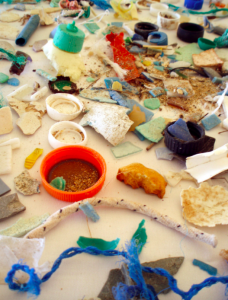Francesco Zangari is a PhD researcher at the University of Toronto in the Department of Molecular Genetics. He studies RNA/protein interactions using state-of-the-art mass spectrometry techniques. Outside the lab, Francesco is a Toronto-based science writer, driven to captivate readers with in-depth stories about the people involved in science and new scientific discoveries. To date, Francesco has written for a variety of outlets like Sinai Health Foundation, Massive Science, Cellular Agriculture Canada and the National Association of Science Writers. You can find more of this work and him on Twitter @franthewriter1.
Ocean contamination has been an issue highlighted since the ‘70s, with research expeditions revealing that our oceans are under attack. Previously thought to be a drastic, future scenario, it appears to be a stark reality that global marine environments and seafood have become increasingly polluted.
As populations continue to grow around the world, there’s been a surging demand for urban-style living resulting in increasing coastal populations. These areas are increasingly popular because of their economic potential, but rapid urbanization is harming marine environments. The influence of coastal urbanization on marine ecosystems has led to an increased danger when consuming seafood.
Cellular agriculture, or the production of food products from cell-based methods, offers a promising and safer solution. Instead of relying on sea life, developments in bioengineering can allow for the production of seafood from specialized cells.
Greg Potter, PhD, is a research scientist at Clean Research working on developing cellular-based seafood. As he explains it, stem cells can be used to produce an entire organism grown outside of animals in sterile and controlled environments. Researchers grow 3D layers of tissue that are cultured to resemble the tissue harvested from the animal. The adoption of cell-based fish offers the opportunity to ease the demand on traditional fish and shellfish stocks, and reduce the consumption of potentially contaminated seafood.
However, Potter notes there remains work to do. “In reality, it will be another 5-10 years until commercial production.”
Current limitations are centred on scaling up production. Technological developments needed like bioreactors—the large brewery-like machines housing the ideal environment to grow the animal tissue—have not been developed yet. In parallel, the mass production of cultured seafood will require the development of a more cost-effective culture medium, the fluid necessary for tissue growth.
Nonetheless, Potter remains cautiously optimistic about the future.
“You get to scan so many different types of cells and systems,” says Potter. “So, you can land on something that is really efficient and ideal for cell-based [seafood] production.”
Researchers interested in marine environments experience first-hand the pollutants and pathogens that cause disease in the water. “It’s not just [doing] the field work and seeing contaminants in the samples, you really experience [them],” says Raechel Littman, a marine biologist at the University of California, Irvine. These experiences have led researchers to ring the alarm bells.
Findings published in Science of the Total Environment highlight the global crisis and identify an alarming number of contaminants within coastal waters and important seafood species. As such, foodborne illnesses related to seafood consumption are on the rise.
In this new paper, Raechel Littman and her colleagues performed one of the first comprehensive surveys of pathogens and contaminants in coastal Myanmar. Their efforts have begun documenting the extensive pollution found in both marine environments and seafood.
The research team began by taking sediment, seawater and oyster tissue samples along the western coast of the rural Tanintharyi Region in Myanmar that is 40km from the city Myiek. The common pearl oyster is often used as a stand-in for seafood contamination, as its filtration abilities promote the build-up of contaminants. The next step involved testing the samples. Using a specialized DNA sequencing approach, researchers looked for identifiers of bacterial DNA. The researchers found 87 species of potential human bacterial pathogens in the samples, with half found in oyster tissue.
“The fact that there’s such a suite of pathogens that can find their way into our food sources is rather concerning,” says Littman. Since oysters are generally eaten raw, these findings highlight a potential for illness.
The researchers’ next step was to assess the pollutant burden. Expecting to see a gradient flowing outward from the city, the extensive pollution surprised researchers as it was spread uniformly across the surveyed landscape, explains Littman. Using the same samples, their analysis revealed over 70 types of contaminants, with approximately one third found in oyster tissue.
It’s important to note that these matters are “a problem all over the world. Even in the United States and Canada. There’s a lot of water quality issues we are trying to get at, so we’re trying to do our work in many places where we can target these issues,” says Littman.
Fortunately, emerging developments in the alternative protein industry can offer solutions to improve food safety via non-animal derived seafood in the long-term. “Overall, however, it’s going to take a lot of research and effort before we can say that cell-based approaches can sustain the large demand for seafood, the largest protein form consumed globally,” Potter explains.
Guest
Latest posts by Guest (see all)
- Regenerative immunotherapy: Hope for chronic autoimmune diseases - September 16, 2025
- Canada’s regenerative revolution: Why AI is the catalyst - September 4, 2025
- Summer by Design: A launchpad for future entrepreneurs and industry scientists - August 14, 2025







Comments